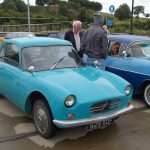WORDS BY STEVE HOLE
Not a kitcar of course, the Citroën Bijou was an incredibly low-volume car for a mainstream manufacturer and had a fascinating story that we think you’ll enjoy.
Citroën is a marque with a quirky past and never afraid to push the boundaries. In addition to the kitcar industry having a fond relationship with the Citroën 2CV underpinnings with many kitcars based on it they also had a factory in the UK, in Slough (1926-1965) where the 2CV was produced.

Other Citroën models produced in Slough included:
Type A
Traction Avant
Light Twelve
Light Fifteen (SWB) or Big Fifteen (LWB)
Six Cylinder or Big Six
2CV
2CV Royal Navy pickup
DS
They also made the GRP-bodied English market Bijou model which was as close to a specialist car as any mainstream manufacturer has ever really got. It was designed by a famous designer associated with Lotus, the late Peter Kirwan-Taylor (often described as the Pinner Pininfarina!) the same man who had a hand in the MkVI and also styled the Elite’s body in 1957.
Incidentally, the fibreglass bodies were initially produced by Whitson & Co, also located in Berkshire. Whitson’s had previous within the specialist car industry as they’d previously produced the bodies for Peerless Cars. They made about 100 Bijou bodies before the work was transferred to CF Taylor of Crawley, West Sussex.

Citroën UK’s bosses were the masterminds behind the Bijou as they felt that there was a disconnect between English buyers and the 2CV, which was thought to be a bit too wacky and quirky for UK tastes.
Cleverly though, the 2CV’s mechanicals and floorpan were retained, as was the interconnected suspension that provided the fabled Citroën Rolls-Royce-like ride quality. The Bijou was launched at the Earls Court Motor Show of 1954.
Although the shape was appealing and the use of existing parts bin components inspired, Citroën didn’t factor in the fact that the 425cc 12bhp engine from the 2CV was even slower in the Bijou as it weighed more than the 2CV! There was definitely a bit of ‘kitcar’ about it and to these eyes I find the charming Bijou looking like it could have come from a kitcar operation like Fairthorpe.
The lack of performance and the £695 (about £11,305, in today’s money) price tag probably put people off. Plus, it’s often forgotten that GRP can be pretty heavy add in the fact that the Bijou had a fully trimmed interior and 2CV, er, didn’t its 605kg versus 2CV’s 533kg put things into perspective.
Although top speed was slightly higher – 50mph versus 47mph – acceleration was considerably reduced.
There are a few myths about the Bijou, including the untrue claim that the windscreen was actually the rear screen of the Safari.
By the time production ended in 1964, just 207 had been sold to UK buyers.











